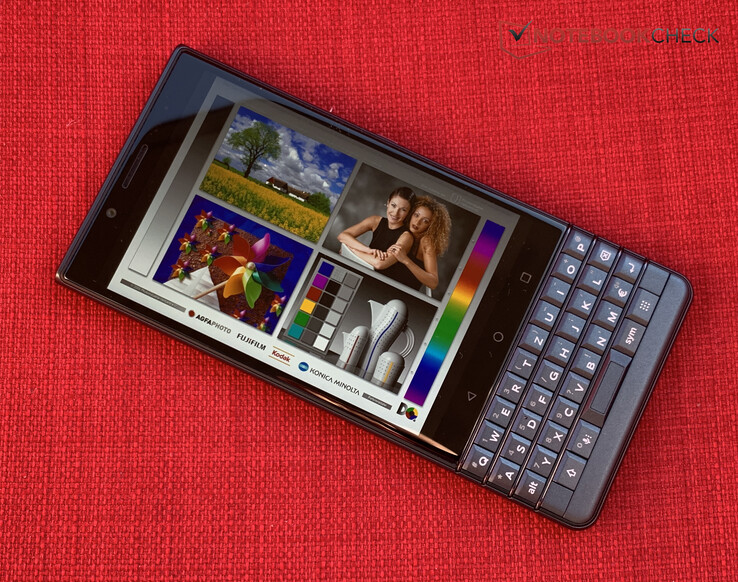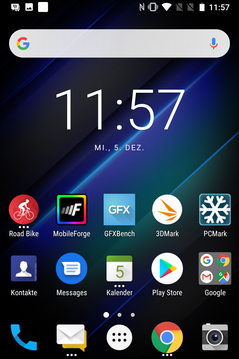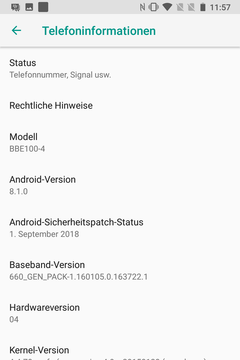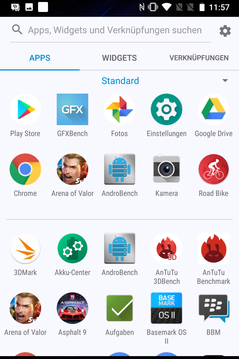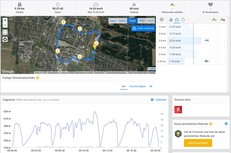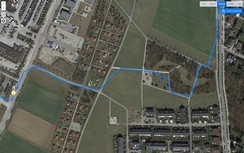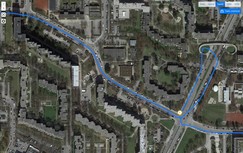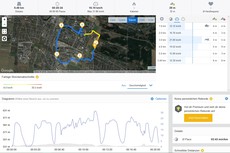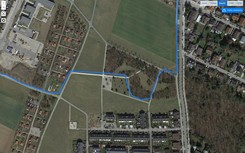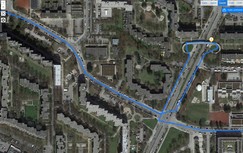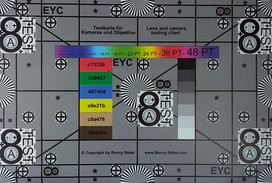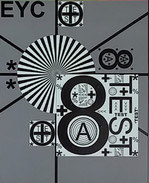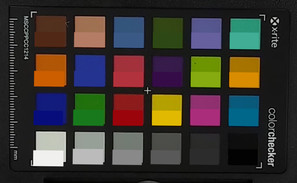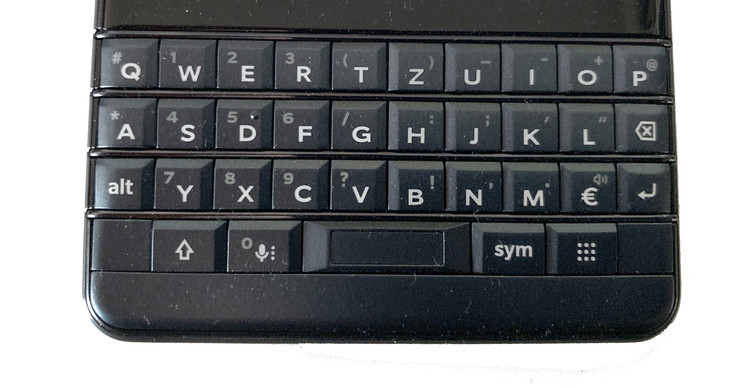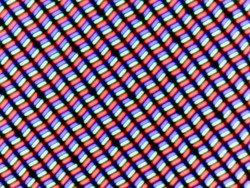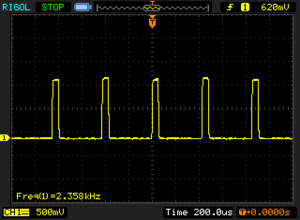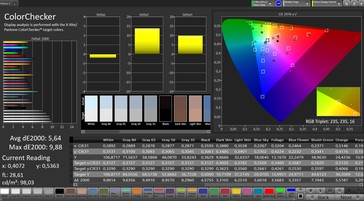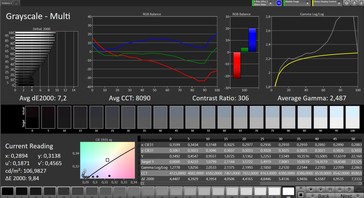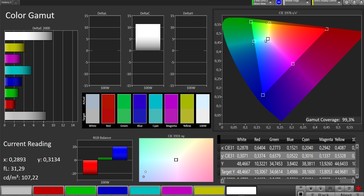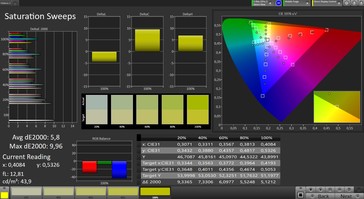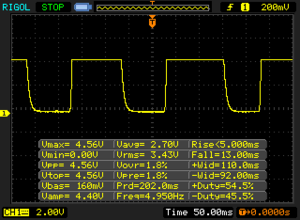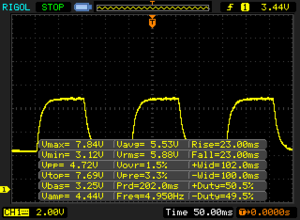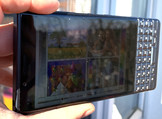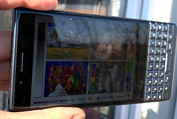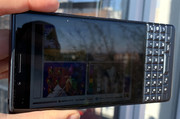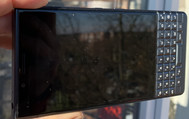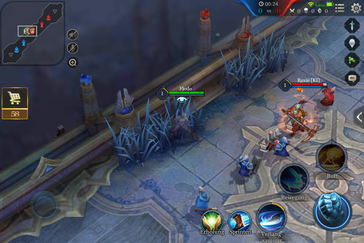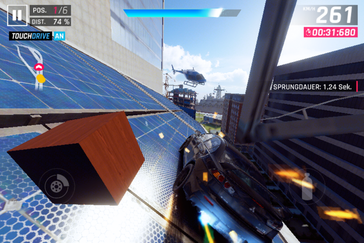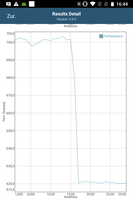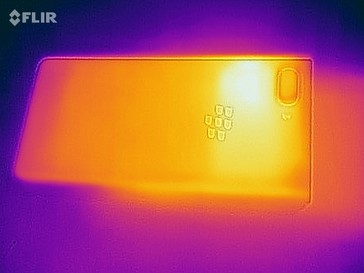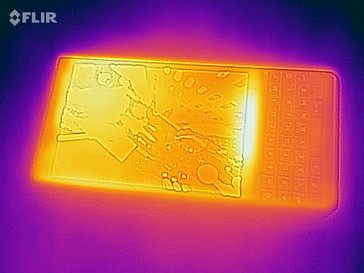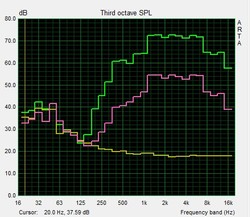BlackBerry KEY2 LE Smartphone Review
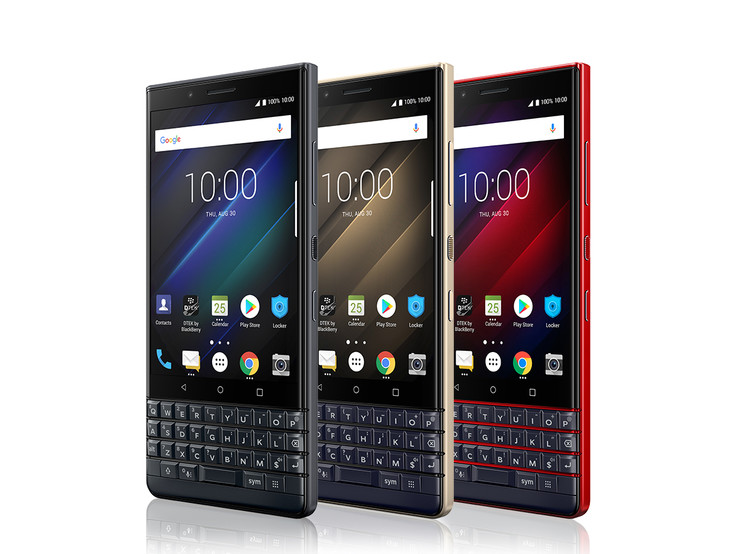
While the iPhone has long replaced the BlackBerry as the must-have company phone, there are still those who are fans of smartphones with physical keyboards. TCL Communication bought the BlackBerry Mobile trading name from BlackBerry Limited in 2016 and has since released several devices that cater to this now niche market. TCL started with the KEYone, which had a touchpad integrated within the space bar, shortcut keys and ran pure Android rather than the BB10 OS.
The company then followed this up with the KEY2, which scored a decent 85% in our review this summer. The KEY2 LE has now arrived into our office and has been waiting for us to put it through its paces. The KEY2 LE currently costs $499.99 online for the 64 GB version, which is $150 cheaper than the KEY2. BlackBerry Mobile also sells a 32 GB version in the UK for £349 (~$445). The KEY2 LE may look like its more expensive sibling, but it is equipped with largely different hardware including 2 GB less RAM, a less powerful SoC, worse cameras and a smaller battery among others.
We would have liked to compare the KEY2 LE against other smartphones with physical keyboards, but unfortunately, the only current alternatives are other BlackBerry devices, which would not make for particularly relevant comparison tables. Instead, we have chosen to compare our test device against other equivalently priced mid-range smartphones such as the Sharp D10 and the Sony Xperia XA2 Plus. We will also compare the KEY2 LE against older flagship devices that currently cost less than $500 such as the LG G7 ThinQ and the Huawei P20.
Case
The BlackBerry KEY2 and KEY2 LE mainly look the same, but there are a few differences. Firstly, the latter comes in more colours. Our test device is the ‘Slate’ version, which looks grey with a blue tint to it in the flesh. The KEY2 LE also comes in ‘Champagne’ and ‘Atomic Red’, the latter of which is dual-SIM and is only available in some markets.
The back of the KEY2 LE has a slightly roughened dot pattern that is grippy, while the device’s rounded corners make it more ergonomic than most modern smartphones. Our test device is also 24 g (~0.85 oz) lighter than the KEY2 and weighs less than all our comparison devices despite having a physical keyboard. The weight reduction has not compromised the KEY2 LE’s structural integrity either. We can twist our test device slightly, which causes the case to creak softly, but we could not cause the display or back case to deform by applying pressure to the device with our hands.
Connectivity
The KEY2 LE comes with either 32 GB or 64 GB of eMMC flash storage, although we could only find the latter version for sale on US online retailers. TCL Communication has also equipped the device with 4 GB of RAM, which is 2 GB less than the KEY2 has. The KEY2 LE also has a headphone jack and a USB 2.0 Type-C port that supports USB On-The-Go (OTG). By contrast, the KEY2 has a USB 3.1 Type-C port, which should provide faster data transfers. All KEY2 LE models support microSD card expansion, but there are currently two single-SIM and two dual-SIM variants. Our test device is the BBE100-4, which is available in Europe and Asia-Pacific. Our test device accepts either two nano SIMs or a single SIM and a microSD card. We have outlined the four variants below.
| Model | Region | SIM type |
|---|---|---|
| BBE100-1 | Europe & Asia-Pacific | Single SIM |
| BBE100-2 | North America & Latin America | Single SIM |
| BBE100-4 | Europe & Asia-Pacific | Dual SIM |
| BBE100-5 | North America, Open market | Dual SIM |
Software
The times when BlackBerry devices came with BlackBerry 10 OS are long gone. The KEY2 LE ships with Android Oreo 8.1 at the time of writing, while our test device arrived with Android security patches from September 1, 2018, which were three months old at the time of testing. We would have expected BlackBerry Mobile to have issued newer security patches by now considering that security is one of the KEY2 LE’s main selling points. We hope that this is rectified soon as it may be a security issue for some users and currently amounts to disingenuous marketing.
Our test device comes with numerous pre-installed apps, including the DTEK security suite, which checks for system vulnerabilities among other things. There is also a secured folder app called Locker and a Privacy Shade, which allows people to redact information from images before sharing them or obscure the entire display except for a specific area. Many of the preinstalled apps are useful in our opinion, but you can uninstall them if you prefer. They are downloadable from the Google Play Store too.
Communication & GPS
The KEY2 LE supports all modern standards up to IEEE 802.11 ac Wi-Fi and can connect to 2.4 GHz or 5 GHz networks. Our test device performed well in iperf3 Client Wi-Fi tests with our Linksys EA8500 reference router, averaging just over 300 MBit/s in both tests. The Huawei P20 and LG G7 ThinQ achieved significantly higher transfer speeds in both tests though.
In practice, websites load quickly on our test device when it is next to a router, but the Wi-Fi reception drops to ¾ when we tested the KEY2 LE around 10 metres (~33 ft) and three walls away from the router. The same websites took longer to load too.
The KEY2 LE supports numerous LTE bands, which should allow the device to work on USA mobile networks, for example. We would stop short of calling the device a World Phone, though as it is missing a few bands and frequencies that more premium devices support. Hence, we would suggest checking what frequencies local carriers support before embarking on intercontinental travel. It is worth noting that our test device maintained good signal on a German D2 network throughout testing.
| Networking | |
| iperf3 transmit AX12 | |
| LG G7 ThinQ | |
| Huawei P20 | |
| Sony Xperia XA2 Plus | |
| BlackBerry Key2 | |
| BlackBerry Key2 LE | |
| Sharp D10 | |
| iperf3 receive AX12 | |
| LG G7 ThinQ | |
| Huawei P20 | |
| Average of class Smartphone (last 2 years) | |
| Sharp D10 | |
| BlackBerry Key2 LE | |
| Sony Xperia XA2 Plus | |
| BlackBerry Key2 | |
Our test device cannot locate us inside buildings, but it achieves a satellite fix with up to 6 metres (~20 ft) accuracy when next to a window. The GPS accuracy then increased up to 4 metres (~13 ft) when tested outside, which is a decent result for a sub-$500 device.
We also took the KEY2 LE on a bike ride to compare its navigation accuracy against the Garmin Edge 520, a professional navigation system. Our test device plotted a 300-metre (~328 yd) shorter route than the Garmin, the reasons for which are demonstrated in the pictures below. The KEY2 LE could not keep up with us through bends, which causes it to cut corners where the Garmin does not. Our test device struggled to plot our bridge crossing accurately too, but so did the Garmin. Overall, the KEY2 LE is accurate enough for general navigation tasks, but we would recommend using a professional navigation device if you need precise location accuracy.
Telephone Features & Call Quality
The KEY2 LE comes with the standard Google Contacts and Phone apps, which work just as well as they do on other devices. The device supports Wi-Fi calling (VoWiFi) and voice over LTE (VoLTE), but these features will only work on networks that have provisioned the KEY2 LE. We would recommend checking whether your carrier supports the device before purchasing it as the German E-Network (E-Netz) supports VoLTE, but we could not activate it on our test device.
The call quality on the KEY 2 LE is great though. The earpiece can get loud and can transmit our call partner’s voice clearly without any background noise. Moreover, the microphones pick our voice out well, even if we speak quietly. Our call partner sounds noticeably thinner over the loudspeaker, but their voice remained clear throughout our test calls.
Cameras
The cameras in the KEY2 LE are noticeably inferior to those in the KEY2, but we suspect that they will still be good enough for business customers. Private buyers should take note though, because comparably priced smartphones like the LG G7 ThinQ take higher-quality photos than the KEY2 LE.
The KEY2 LE has dual rear-facing cameras like its more expensive sibling, but the device uses its secondary sensor just for producing bokeh effect photos rather than to improve the quality of low-light photos. The main camera is a 13 MP sensor, which is 1 MP more than the equivalent in the KEY2. However, the former has an f/2.2 aperture, which will let in less light and capture scenes in less detail than the f/1.8 aperture sensor in the KEY2. The main camera in the KEY2 LE can take decent photos in normal daylight with good colour reproduction, but the degree of detail that it can capture falls short of the cameras in more expensive smartphones. The camera’s low-light performance is unimpressive though. Resulting photos are noisy and are poorly exposed.
Our test device can record videos in up to 4K at 30 FPS, and the results look good generally with the camera sensor adjusting exposure levels quickly when needed. The colour reproduction is too weak for our liking though.
The front-facing camera is an 8 MP sensor just like the one in the KEY2. Photos taken with the front-facing camera have decent dynamic range and are suitably detailed. Objects such as faces look sharp too, but we can spot colour noise in dark areas.
We also subjected the KEY2 LE to further camera tests under controlled lighting conditions in our lab. Overall, the photo of our test chart looks rather blurry, but the main camera captures colours well, albeit in a somewhat uneven manner.
Accessories & Warranty
The KEY2 LE comes with a charger, a USB Type-A to Type-C cable, a SIM tool, a quick start guide and warranty information. There are also a pair of headphones that sound comparatively good for bundled headphones. The device also comes with 24 months manufacturer’s warranty for retail purchases. Please see our Guarantees, Return policies and Warranties FAQ for country-specific information.
Input Devices & Operation
The physical keyboard has typically been a unique selling point of BlackBerry smartphones, except for some later RIM devices such as the Z10 and the Z30 among others. There is also the touchscreen-only and TCL-produced BlackBerry Motion that the company released in October 2017, but BlackBerry Mobile is in no way moving away from its physical keyboard heritage.
The keyboard on the KEY2 LE looks like the one in the KEY2, but it lacks the support for touch gestures that its more expensive sibling has. There is keyboard backlighting though, which is a bonus for typing at night. We found the keyboard quick to type on, but it will take some acclimatisation if you are used to using a virtual keyboard. We would recommend typing with both thumbs as this allowed us to type much faster than if we tried using our fingers or a single thumb. You can disable the keyboard if you would rather use a virtual keyboard instead too.
The KEY2 LE retains some of the special spacebar features that we have seen on the KEYone and the KEY2. TCL has incorporated a fingerprint sensor within the flat section of the spacebar, which reliably unlocked our test device quickly throughout testing. The spacebar doubles as a camera shortcut button too. The KEY2 LE also retains the shortcut key, which is freely assignable to short and long presses.
TCL has stuck to using physical navigation buttons too, which are backlit and reacted just as reliably as capacitive buttons do. The touchscreen on our test also responded accurately even at the edges of the display.
The remaining hardware buttons are all located on the right-hand side of the device. The power button has a textured finish that is easy to feel when holding the device, which is sandwiched between the volume rocker and the freely assignable comfort button.
Display
The KEY2 LE and KEY2 both have 4.5-inch IPS displays with a 1,620 x 1,080 native resolution. All our comparison devices have 1080p displays except for the higher resolution LG G7 ThinQ. The KEY2 LE has a comparable pixel density to our comparison devices too despite its lower resolution.
Interestingly, our test device achieved a higher average maximum brightness according to X-Rite i1Pro 2 than its more expensive sibling. The display will only reach its maximum peak average luminosity of 644 cd/m² with the ambient light sensor activated. However, the KEY2 LE still finishes in the midfield of our comparison table and is well behind the LG G7 ThinQ. Our test device has a 91% evenly lit display too, which is on par with our comparison devices and will make large areas of colour look homogenous.
| |||||||||||||||||||||||||
Brightness Distribution: 91 %
Contrast: 1404:1 (Black: 0.48 cd/m²)
ΔE Color 5.64 | 0.5-29.43 Ø5
ΔE Greyscale 7.2 | 0.57-98 Ø5.3
99.3% sRGB (Calman 2D)
Gamma: 2.487
| BlackBerry Key2 LE IPS, 1620x1080, 4.50 | BlackBerry Key2 IPS, 1620x1080, 4.50 | Sony Xperia XA2 Plus IPS, 2160x1080, 6.00 | LG G7 ThinQ IPS, 3120x1440, 6.10 | Huawei P20 LTPS, 2240x1080, 5.80 | Sharp D10 IPS, 2160x1080, 5.90 | |
|---|---|---|---|---|---|---|
| Screen | 6% | 26% | 18% | 41% | 4% | |
| Brightness middle | 674 | 569 -16% | 597 -11% | 974 45% | 753 12% | 745 11% |
| Brightness | 644 | 548 -15% | 592 -8% | 975 51% | 748 16% | 723 12% |
| Brightness Distribution | 91 | 93 2% | 92 1% | 96 5% | 96 5% | 89 -2% |
| Black Level * | 0.48 | 0.35 27% | 0.32 33% | 0.49 -2% | 0.37 23% | 0.6 -25% |
| Contrast | 1404 | 1626 16% | 1866 33% | 1988 42% | 2035 45% | 1242 -12% |
| Colorchecker dE 2000 * | 5.64 | 5 11% | 2.4 57% | 5.4 4% | 1.3 77% | 4.52 20% |
| Colorchecker dE 2000 max. * | 9.88 | 10.1 -2% | 5.3 46% | 13.1 -33% | 2.3 77% | 9.14 7% |
| Greyscale dE 2000 * | 7.2 | 5.4 25% | 3.4 53% | 5 31% | 1.7 76% | 5.8 19% |
| Gamma | 2.487 88% | 2.6 85% | 2.2 100% | 2.31 95% | 2.18 101% | 2.262 97% |
| CCT | 8090 80% | 7424 88% | 7172 91% | 7480 87% | 66.76 9736% | 7660 85% |
* ... smaller is better
Screen Flickering / PWM (Pulse-Width Modulation)
| Screen flickering / PWM detected | 2358 Hz | ≤ 15 % brightness setting | |
The display backlight flickers at 2358 Hz (worst case, e.g., utilizing PWM) Flickering detected at a brightness setting of 15 % and below. There should be no flickering or PWM above this brightness setting. The frequency of 2358 Hz is quite high, so most users sensitive to PWM should not notice any flickering. In comparison: 53 % of all tested devices do not use PWM to dim the display. If PWM was detected, an average of 17900 (minimum: 5 - maximum: 3846000) Hz was measured. | |||
Unfortunately, the KEY2 LE uses pulse-width modulation (PWM) to regulate display brightness, which can cause eye strain or headaches for some people. We measure a 2,358 Hz PWM frequency at 15% luminosity and below, which should be a high enough frequency to not disturb even those who are PWM sensitive.
We also analysed our test device with CalMAN analysis software, which reproduced the blue tint that we can even see by looking at the display. Our test device achieves decent sRGB colour space coverage too, but unfortunately CalMAN only indicates the degree of coverage.
Display Response Times
| ↔ Response Time Black to White | ||
|---|---|---|
| 18 ms ... rise ↗ and fall ↘ combined | ↗ 5 ms rise | |
| ↘ 13 ms fall | ||
| The screen shows good response rates in our tests, but may be too slow for competitive gamers. In comparison, all tested devices range from 0.1 (minimum) to 240 (maximum) ms. » 34 % of all devices are better. This means that the measured response time is better than the average of all tested devices (21.5 ms). | ||
| ↔ Response Time 50% Grey to 80% Grey | ||
| 46 ms ... rise ↗ and fall ↘ combined | ↗ 23 ms rise | |
| ↘ 23 ms fall | ||
| The screen shows slow response rates in our tests and will be unsatisfactory for gamers. In comparison, all tested devices range from 0.2 (minimum) to 636 (maximum) ms. » 76 % of all devices are better. This means that the measured response time is worse than the average of all tested devices (33.7 ms). | ||
The KEY2 LE is usable outdoors thanks to its bright display. However, we would recommend using the device in the shade on sunny days as its display has a highly reflective finish, which makes reading what is being displayed onscreen a chore.
Our test device has strong viewing angles because of its IPS display. Unfortunately, we noticed significant brightness distortions at acute viewing angles, which is atypical of devices with the same display technology.
Performance
The KEY2 LE is powered by the Qualcomm Snapdragon 636 SoC, which is slightly less powerful than the Snapdragon 660 SoC powering the KEY2. Our test device typically finished between 20% and 25% behind its more expensive sibling, but the real-world difference is not as clear-cut. The KEY2 will feel faster if you regularly run numerous apps simultaneously because of its more powerful SoC and its 2 GB extra RAM, while complex apps may run more smoothly. However, the performance differences will be negligible during less resource intensive tasks such as web browsing or sending a few messages.
The Snapdragon 636 SoC integrates a Qualcomm Adreno 509 GPU that regularly finished behind most of our comparison devices in graphics-intensive benchmarks such as GFXBench. Our test device consistently finished above the Xperia XA2 Plus and the Sharp D10 with their Adreno 508 GPUs, but the Adreno 509 averaged around 30% lower scores than the Adreno 512 that handles graphics in the KEY2.
| AnTuTu v7 - Total Score (sort by value) | |
| BlackBerry Key2 LE | |
| BlackBerry Key2 | |
| Sony Xperia XA2 Plus | |
| LG G7 ThinQ | |
| Huawei P20 | |
| Sharp D10 | |
| Average Qualcomm Snapdragon 636 (115565 - 138661, n=11) | |
| AnTuTu v6 - Total Score (sort by value) | |
| BlackBerry Key2 LE | |
| BlackBerry Key2 | |
| Sony Xperia XA2 Plus | |
| LG G7 ThinQ | |
| Huawei P20 | |
| Sharp D10 | |
| Average Qualcomm Snapdragon 636 (92015 - 125213, n=10) | |
There is also a clear gap between the KEY2 LE and the KEY2 in browser benchmarks. The KEY2 LE outscored the P20 and scored 16% higher than the average of Snapdragon 636 powered devices that we have currently tested in WebXPRT 2015 though, which is somewhat surprising.
The KEY2 LE loads websites swiftly in daily use, but media content often takes slightly longer to load. The KEY2 is noticeably faster in this respect. Elaborate HTML5 websites such as Google Interland run smoothly and load quickly though.
| JetStream 1.1 - Total Score | |
| Average of class Smartphone (last 2 years) | |
| LG G7 ThinQ (Chrome 66) | |
| Huawei P20 (Chrome 66.0.3359.126) | |
| BlackBerry Key2 (Chrome 67) | |
| Average Qualcomm Snapdragon 636 (44.2 - 51.5, n=11) | |
| BlackBerry Key2 LE (Chrome 70) | |
| Sharp D10 (Chrome 70) | |
| Sony Xperia XA2 Plus (Chrome 67) | |
| Octane V2 - Total Score | |
| Average of class Smartphone (4633 - 89112, n=212, last 2 years) | |
| LG G7 ThinQ (Chrome 66) | |
| Huawei P20 (Chrome 66.0.3359.126) | |
| BlackBerry Key2 (Chrome 67) | |
| Average Qualcomm Snapdragon 636 (8163 - 9746, n=12) | |
| BlackBerry Key2 LE (Chrome 70) | |
| Sony Xperia XA2 Plus (Chrome 67) | |
| Sharp D10 (Chrome 70) | |
| Mozilla Kraken 1.1 - Total | |
| Sony Xperia XA2 Plus (Chrome 67) | |
| Sharp D10 (Chrome 70) | |
| Average Qualcomm Snapdragon 636 (4105 - 5066, n=12) | |
| BlackBerry Key2 LE | |
| Huawei P20 (Chrome 66.0.3359.126) | |
| BlackBerry Key2 (Chrome 67) | |
| LG G7 ThinQ (Chrome 66) | |
| Average of class Smartphone (388 - 9999, n=173, last 2 years) | |
| WebXPRT 3 - Overall | |
| Average of class Smartphone (39 - 304, n=122, last 2 years) | |
| LG G7 ThinQ (Chrome 66) | |
| Huawei P20 | |
| BlackBerry Key2 LE (Chrome 70) | |
| Average Qualcomm Snapdragon 636 (46 - 61, n=9) | |
| Sony Xperia XA2 Plus (Chrome 67) | |
| WebXPRT 2015 - Overall | |
| LG G7 ThinQ (Chrome 66) | |
| BlackBerry Key2 LE (Chrome 70) | |
| Huawei P20 (Chrome 66.0.3359.126) | |
| Average Qualcomm Snapdragon 636 (147 - 184, n=8) | |
| Sony Xperia XA2 Plus (Chrome 67) | |
* ... smaller is better
It appears TCL has used the same microSD card reader in the KEY2 LE and the KEY2 as they both achieved almost identical transfer speeds in AndroBench 3-5. Our test device is on par with our comparison devices too, although the Xperia XA2 Plus has slightly higher read and write speeds. File transfers will finish quicker on the Xperia XA2 Plus, but the time saved will be negligible in daily use.
The KEY2 LE is equipped with eMMC flash storage, which is considerably slower than its UFS 2.1 counterpart that manufacturers often use in their flagship devices. The G7 ThinQ and P20 are two such devices, so inevitably our test device falls well short of them both in internal storage benchmarks such as AndroBench 3-5. However, the KEY2 LE averaged around 19% faster transfer speeds than the average of devices with 64GB of eMMC storage that we have tested. Our test device finished well above the class average too.
| BlackBerry Key2 LE | BlackBerry Key2 | Sony Xperia XA2 Plus | LG G7 ThinQ | Huawei P20 | Sharp D10 | Average 64 GB eMMC Flash | Average of class Smartphone | |
|---|---|---|---|---|---|---|---|---|
| AndroBench 3-5 | -10% | -14% | 27% | 242% | -10% | -1% | 574% | |
| Sequential Read 256KB | 306.7 | 273.1 -11% | 281.1 -8% | 695 127% | 827 170% | 280.7 -8% | 273 ? -11% | 1502 ? 390% |
| Sequential Write 256KB | 213.8 | 208.4 -3% | 146.2 -32% | 176.4 -17% | 193.6 -9% | 211.5 -1% | 176.8 ? -17% | 1111 ? 420% |
| Random Read 4KB | 92.1 | 56.8 -38% | 77.4 -16% | 110.5 20% | 147 60% | 47.2 -49% | 59.1 ? -36% | 247 ? 168% |
| Random Write 4KB | 19.1 | 17.18 -10% | 10.5 -45% | 23.26 22% | 161.5 746% | 16.79 -12% | 31.7 ? 66% | 271 ? 1319% |
| Sequential Read 256KB SDCard | 82.4 ? | 82.5 ? 0% | 86 ? 4% | 84.7 ? 3% | 83.2 ? 1% | 77.4 ? -6% | ||
| Sequential Write 256KB SDCard | 59.6 ? | 61.7 ? 4% | 67 ? 12% | 62.7 ? 5% | 63.6 ? 7% | 58.3 ? -2% |
Games
The Adreno 509 GPU is powerful enough to handle complex and modern games with minimal stuttering. Our test device averaged around 30 FPS in "Asphalt 9: Legends" and "Arena of Valor" regardless on high or low graphics, so overall the KEY2 LE is suitable for some light gaming after work in our opinion.
The integrated GPU supports all modern graphics standards, so the KEY2 LE should be able to play most games that are released in the next few years. It is even possible to use the keyboard as an input device while gaming, but games currently only play in landscape mode, which limited us to using the keyboard with only one hand. Hence, we would not currently recommend using the keyboard while gaming as it is a pain to use.
The positional sensor and touchscreen worked perfectly throughout our games tests. We had no issues when playing fast-paced games such as "Temple Run 2", during which the touchscreen reacted quickly, while the positional sensor maintained the correct display orientation for the game in question.
Emissions
Temperature
The KEY2 LE manages its surface temperatures well. Our test device reached a maximum of 38.8 °C (~102 °F), but no problem. Towards the keyboard, the temperature also decreases.
We also subjected our test device to a loop of the GFXBench Battery Test to determine how well it maintains its peak performance under sustained load. The KEY2 LE performed comparatively well and only experienced a performance drop of around 10% by the 17th benchmark loop. In short, you should not experience thermal throttling in daily use.
(+) The maximum temperature on the upper side is 37 °C / 99 F, compared to the average of 35 °C / 95 F, ranging from 21.9 to 56 °C for the class Smartphone.
(+) The bottom heats up to a maximum of 38.8 °C / 102 F, compared to the average of 33.8 °C / 93 F
(+) In idle usage, the average temperature for the upper side is 27 °C / 81 F, compared to the device average of 32.7 °C / 91 F.
Speakers
The KEY2 LE has a small mono speaker on the underside of the device, which does its job well. The audio produced sounds warm, and there is no distortion even at maximum volume. However, the speakers struggle to reproduce bass tones like many other smartphone speakers, and high tones are overrepresented at maximum volume to the extent that the audio sounds too shrill for our liking.
TCL has included a headphone jack, which reproduces audio cleanly. The included headphones are comparatively good too. Our test device also worked perfectly with Bluetooth headphones and speakers during our tests.
BlackBerry Key2 LE audio analysis
(+) | speakers can play relatively loud (82.4 dB)
Bass 100 - 315 Hz
(-) | nearly no bass - on average 66.6% lower than median
(+) | bass is linear (0% delta to prev. frequency)
Mids 400 - 2000 Hz
(-) | nearly no mids - on average 66.6% lower than median
(+) | mids are linear (0% delta to prev. frequency)
Highs 2 - 16 kHz
(-) | nearly no highs - on average 66.6% lower than median
(+) | highs are linear (0% delta to prev. frequency)
Overall 100 - 16.000 Hz
(-) | overall sound is not linear (123.7% difference to median)
Compared to same class
» 92% of all tested devices in this class were better, 7% similar, 2% worse
» The best had a delta of 12%, average was 38%, worst was 134%
Compared to all devices tested
» 97% of all tested devices were better, 2% similar, 1% worse
» The best had a delta of 4%, average was 25%, worst was 134%
BlackBerry Key2 audio analysis
(+) | speakers can play relatively loud (85.9 dB)
Bass 100 - 315 Hz
(-) | nearly no bass - on average 28.4% lower than median
(±) | linearity of bass is average (11.3% delta to prev. frequency)
Mids 400 - 2000 Hz
(±) | higher mids - on average 5.3% higher than median
(+) | mids are linear (6.1% delta to prev. frequency)
Highs 2 - 16 kHz
(±) | higher highs - on average 10.1% higher than median
(+) | highs are linear (4.7% delta to prev. frequency)
Overall 100 - 16.000 Hz
(±) | linearity of overall sound is average (26.6% difference to median)
Compared to same class
» 63% of all tested devices in this class were better, 6% similar, 31% worse
» The best had a delta of 12%, average was 38%, worst was 134%
Compared to all devices tested
» 79% of all tested devices were better, 4% similar, 17% worse
» The best had a delta of 4%, average was 25%, worst was 134%
Power Management
Power Consumption
The KEY2 LE is a relatively power efficient device, although it consumed increasingly more than its more expensive sibling the harder we pushed it. Our test device consumes a minimum of 0.6 W when idling and a maximum of 8.3 W under load, both of which are slightly higher than what the KEY2 consumes. The KEY2 LE finished in the midfield of our comparison table and only consumed less on average than the considerably more powerful G7 ThinQ and the P20.
| Idle | |
| Load |
|
| BlackBerry Key2 LE 3000 mAh | BlackBerry Key2 3500 mAh | Sony Xperia XA2 Plus 3580 mAh | LG G7 ThinQ 3000 mAh | Huawei P20 3400 mAh | Sharp D10 2900 mAh | Average Qualcomm Snapdragon 636 | Average of class Smartphone | |
|---|---|---|---|---|---|---|---|---|
| Power Consumption | 9% | 18% | -26% | -18% | 20% | -25% | -10% | |
| Idle Minimum * | 0.6 | 0.56 7% | 0.35 42% | 1.16 -93% | 0.67 -12% | 0.7 -17% | 0.944 ? -57% | 0.897 ? -50% |
| Idle Average * | 1.4 | 1.51 -8% | 1.81 -29% | 1.98 -41% | 2.05 -46% | 1 29% | 2.22 ? -59% | 1.452 ? -4% |
| Idle Maximum * | 2 | 1.54 23% | 1.83 8% | 2.07 -4% | 2.11 -6% | 1.4 30% | 2.54 ? -27% | 1.629 ? 19% |
| Load Average * | 4.8 | 3.94 18% | 3.31 31% | 4.51 6% | 6.15 -28% | 3.7 23% | 4.51 ? 6% | 5.55 ? -16% |
| Load Maximum * | 8.3 | 7.87 5% | 4.97 40% | 8.3 -0% | 8.09 3% | 5.2 37% | 7.37 ? 11% | 8.31 ? -0% |
* ... smaller is better
Battery Life
The KEY2 LE has a 3,000 mAh battery, which is 500 mAh smaller than the one in the KEY2. However, our test device’s smaller battery is counteracted by its less powerful hardware as both devices achieved similar runtimes in our Wi-Fi battery life test. The KEY2 LE lasted 11:24 hours compared to the KEY 2’s 10:51 hours runtime, but both devices fall far short of the 13:57 hours for which the Xperia XA2 Plus lasted. Overall, the KEY2 LE should last most people a full working day’s use, but we would recommend the Huawei P20 or the Xperia XA2 Plus of our comparison devices if you need a smartphone with a particularly long battery life.
The included charger recharges our test device fully in under two hours.
| BlackBerry Key2 LE 3000 mAh | BlackBerry Key2 3500 mAh | Sony Xperia XA2 Plus 3580 mAh | LG G7 ThinQ 3000 mAh | Huawei P20 3400 mAh | Sharp D10 2900 mAh | |
|---|---|---|---|---|---|---|
| Battery Runtime | -5% | 83% | 3% | 15% | -6% | |
| Reader / Idle | 1677 | 4682 179% | 1662 -1% | 1888 13% | ||
| H.264 | 734 | 893 22% | 908 24% | 810 10% | ||
| WiFi v1.3 | 684 | 651 -5% | 837 22% | 591 -14% | 818 20% | 644 -6% |
| Load | 254 | 529 108% | 260 2% | 295 16% |
Pros
Cons
Verdict
The BlackBerry KEY2 is the representation of BlackBerry Mobile’s, or rather TCL Communication’s, great idea of releasing a cheaper version of its flagship smartphone. After all, not everyone can or wants to pay over $600 for a smartphone. In short, TCL has created a slimmed down version of the KEY2 without sacrificing in key areas. The performance difference between the KEY2 LE and the KEY2 is hardly noticeable unless they are both pushed hard, while both devices have comparable battery life despite the former having a 500 mAh smaller battery. Moreover, we suspect that the KEY2 LE’s weaker camera will not affect business customers. The only practical compromise is the lack of keyboard touch gestures, which proved useful during our time with the KEY2.
Slimmed down, but in the right places. The BlackBerry KEY2 LE is a decent business smartphone with a physical keyboard that retains most of the KEY2’s best features.
However, it is frustrating that our test device has three-month-old Android security patches when the device is marketed as being more secure than other Android smartphones. TCL also includes plenty of pre-installed apps, which may put off some people who prefer a cleaner Android experience. The display is underwhelming too, but the GPS accuracy, build quality and performance are impressive for a sub-$500 smartphone.
Overall, we would recommend the KEY2 LE to those who want a smartphone with a physical keyboard but want to keep costs down. The device is better value for money than its more expensive sibling, but the KEY2 is the better of the two for just $150 more at the time of writing.
BlackBerry Key2 LE
-
12/06/2018 v6(old)
Florian Schmitt


 Deutsch
Deutsch English
English Español
Español Français
Français Italiano
Italiano Nederlands
Nederlands Polski
Polski Português
Português Русский
Русский Türkçe
Türkçe Svenska
Svenska Chinese
Chinese Magyar
Magyar